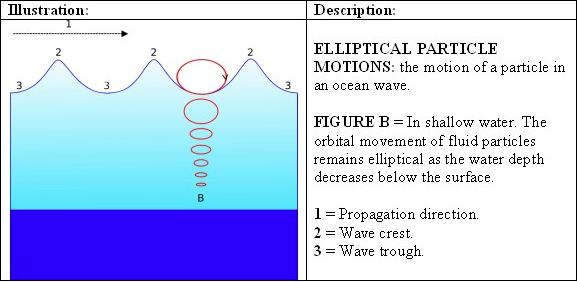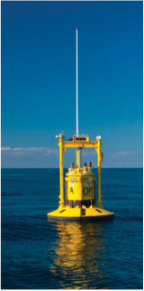Wave Resource
The wave resource is available worldwide, but some specific sites need to be selected in order to analyse how the devices behave in different wave characteristics. As we can see from the next figure, Europe is one of the areas where there is high amount of energy potential per meter wave.
As wind passes over the surface of the ocean this conversion of energy creates waves. When the waves propagate slower than the speed of the wind at the surface of the sea, this allows the energy transfer from wind to waves to occur. The air pressure differences in the left side of the wave crest, and the upwind combined with the friction on the surface of the water caused by the wind, creates shear stress that allows the waves to grow.
It is three factors that usually determine the size formation of wind waves:
The greater these variable are the larger the waves will become. It is then each wave is characterized by:
Wave velocity is also important when it come to measuring the type of waves in a given site. In storm sea states the fastest waves are usually the ones with the longest wavelengths. This is seen as the first storm waves that often arrive on the coast usually have long wavelength swells. When there are several waves present in a short interval of time often these are characterized as wave groups.
Wave energy devices can convert the kinetic energy present in waves to electricity. This energy density can be represented by the following formula:
- The speed of the wind,
- The distance of the body of water that the wind has blown over,
- The amount of time taken for the wind to blow over the body of water.
The greater these variable are the larger the waves will become. It is then each wave is characterized by:
- Height,
- Length,
- Period (the time interval of the crest at a stationary point),
- Direction.
Wave velocity is also important when it come to measuring the type of waves in a given site. In storm sea states the fastest waves are usually the ones with the longest wavelengths. This is seen as the first storm waves that often arrive on the coast usually have long wavelength swells. When there are several waves present in a short interval of time often these are characterized as wave groups.
Wave energy devices can convert the kinetic energy present in waves to electricity. This energy density can be represented by the following formula:
|
These characteristics are important for the site selection of a wave energy device. Ocean waves have been monitored for over 130 years. The recorded wave climate is often accompanied by information provided by seismometers. Wave poles placed on a fixed structure record the more accurate data. Often these poles are a part of a weather monitoring station located along the coastlines or associated with a lighthouse. When choosing an optimal site for a wave energy device the optimal
annual sea states for this device to perform in must be chosen. The site is then chosen if the recorded data shows that the device will perform well in that site’s annual seastates. The wave climates are usually modeled using the recorded data of the site. This information is then combined with a theoretical model of the wave energy device and if it shown to perform well in the site then physical tests are done.
|
For this project we studied four different sites which enabled us to compare the influence of the location and the wave resource in a wave energy plant. To read more about it, click on the next button.




